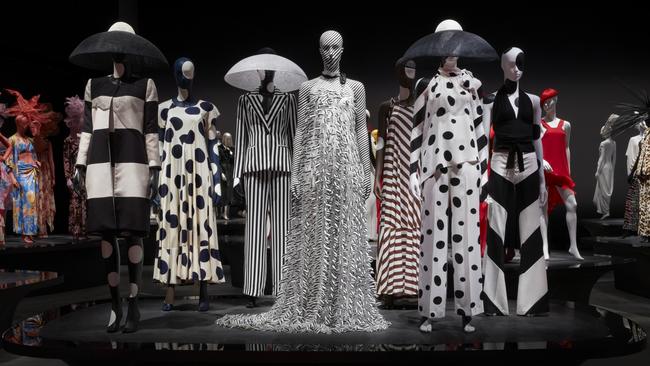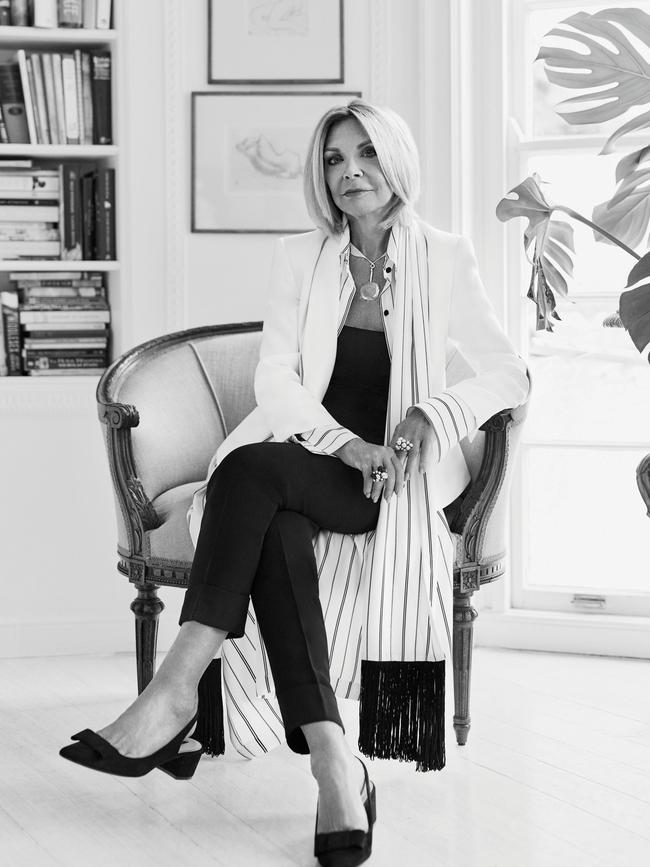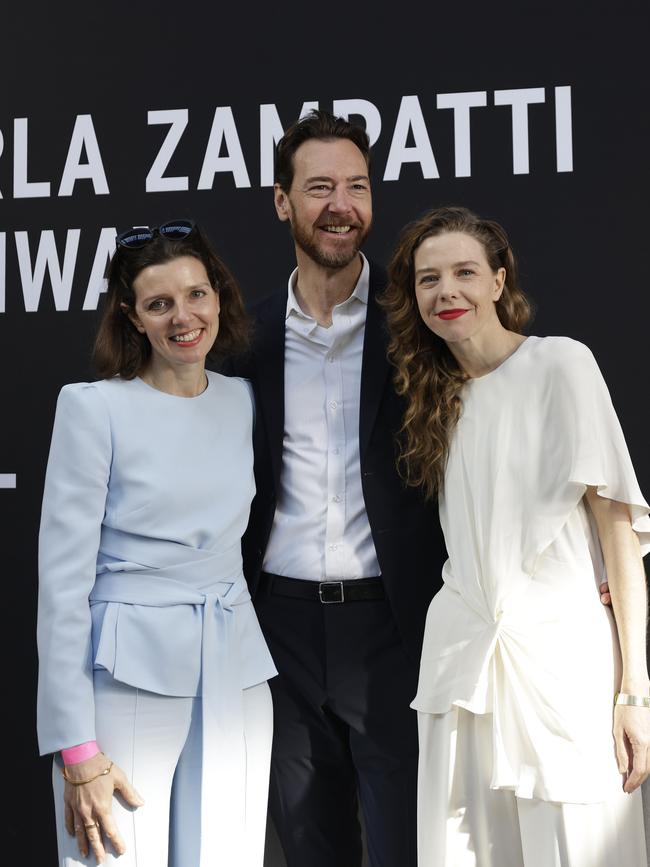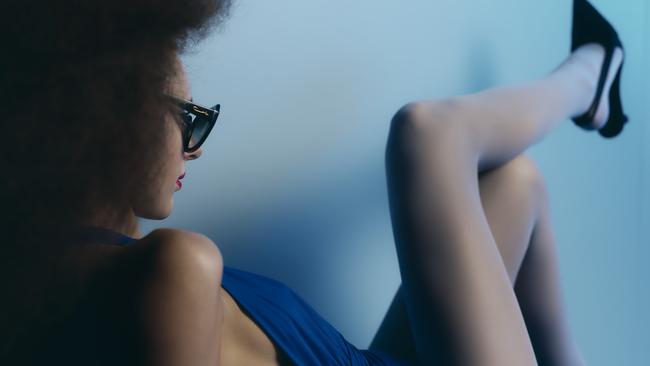The looks that made Carla Zampatti a legend
Family, friends and fans are the driving force of the Zampatti exhibition.

When Roger Leong first stepped inside Carla Zampatti’s fashion archive – unconventionally housed in one of the spare rooms of the late designer’s sprawling Woollahra mansion – he realised his team had a problem.
Tasked with presenting a retrospective of Zampatti’s six-decade-long career, the Museum of Applied Arts & Sciences curator realised the extensive collection of past designs was largely incomplete.
“It was quite overwhelming,” Leong recalls as he takes The Australian through a preview of the exhibition. “There were about 15 racks – maybe a thousand pieces – crammed into one of her spare bedrooms. But it was missing designs from her earlier collections; there were only two pieces from the ’70s and none from the ’60s.”
But sometimes perceived problems ultimately prove the greatest blessings. The lack of early designs inspired a nationwide plea to her longtime fans and customers to contribute their own pieces to the exhibition.
The stories that emerged from the call-out – from celebrities and everyday Australians who had celebrated life milestones in Zampatti’s designs – have become a key part of the retrospective, which opens at Sydney’s Powerhouse Museum on Thursday.
Among the collection, which is comprised of 100 looks, more than half were donated by members of the public and Zampatti’s celebrity clientele, including Maggie Tabberer, Dame Quentin Bryce, Christine Holgate and Julia Gillard.
Two megalithic hollow pods, which were 3D-printed in Byron Bay, have been assembled within the space and will feature recordings of interviews with Zampatti’s clientele, friends, family and the designer herself.
With regard to those who contributed to the exhibition, “we’ve got everyone from former prime ministers to women who worked at car rental companies”, Leong muses.


As testament to Zampatti’s focus on quality, and the respect with which her customers showed her pieces, most of the garments donated were in great condition.
“Some needed extensive dry-cleaning and repair,” Leong says, “but it was pretty astounding that most of the pieces that we picked from the ladies who offered pieces, how well they looked after them; these women had treasured these pieces.”
Even the red 1985 Carla Zampatti Ford Laser, which greets guests at the entrance to the exhibition, had been lovingly restored by owner Mark Kimmorley.
“He had it ducoed, restored the trim, and the branded upholstery is perfect,” Leong explains.
He points to a bouclé cardigan from the late ’70s. “Diane Frost, who lent it, remembers going out dancing in it with hotpants and no bra, and she said every so often her nipple would pop out. She let us write that!” he adds.

Leong points to a brown-and-white-striped maxi dress, which was designed by Denise Hellgren, who worked for Zampatti in the ’70s and ’80s.
“Denise created that dress using six metres of fabric,” he says. Ever the savvy businesswoman, Zampatti’s aversion to unnecessary expense had caused Hellgren to worry about her reaction to the excess fabric used in the design.
“She was terrified Carla would get angry because lots of fabric equalled lots of cost, but when Carla came back from overseas she loved it and it turned out to be one of the bestsellers,” he says.
For singer songwriter Tina Arena, it was Zampatti’s understanding of the female form and her classic approach to silhouettes that engendered her love for the brand.
They also share a mutual aversion to knees.
“Length is something that’s very important to me, and that’s something she got when she was alive, she always went below the knee,” Arena explains, “because she didn’t like her knees, so she didn’t want to show them. It’s very Italian, donna Italiana, it’s very much that sort of look and length, and I really appreciated that very much.”
A black, fitted Carla Zampatti jumpsuit Arena wore in 2015 for her induction into the ARIA Hall of Fame is among the pieces showcased in the exhibition.
“The piece fitted like a glove,” Arena says.
“Everybody sort of gawked at the breast section; it knocked them between the eyes a little bit … but it was easy to move in and it made me feel languid while I was wearing it.
“When I moved the fabric moved with me, and the body shape, she really got.”
The exhibition may be a retrospective of the iconic brand and its founder, but it also hints at the future of the family business.
The slim brunette modelling the brand’s retro designs on posters and billboards promoting the exhibition is Zampatti’s eldest granddaughter, Brigid.

Alex Schuman, Zampatti’s son, who now runs the brand, said he was nervous when the museum proposed the idea to shoot his daughter for the campaign.
“She’s not a model, she’s actually an economics student,” he explained. “It was an unusual request but the Powerhouse talked us into it, and to bring along the next generation on this journey, it was really lovely.”
Schuman admits the idea of permanently giving so many archival designs to the Powerhouse was daunting. “So much of what we do is understanding fit and silhouettes, so it’s a difficult thing to surrender,” he says. “We do use the archives, and there is so much richness within that that we can develop further, but having lost the brand’s ambassador, we’ve crystallised and essentially surrendered the brand into (Zampatti’s) life’s mission, which is the empowerment of women, support of the arts – it’s those things we’re working very hard on and encouraging staff to take up as we look forward.”
For Schuman, the edit of designs from Zampatti’s early years in fashion, at a time when he was a young child, is a personal highlight.
“The ’70s pod with all the old prints, and the jumpsuits and dresses really jump out at me,” he says. “As a small kid, Mum and I lived alone, before we moved in with John Spender, and those are all the things she wore at the time; like the outrageous bell bottom pants.”
For Zampatti’s daughter, Bianca, Schuman says her memories of her mum’s style as a child were more so a reflection of the following decade.
“Bianca’s memories are of all the power dressing; the big shoulders, the ’80s silhouettes.”
Schuman says the entrance to the exhibit – a red carpet that runs along the wall bearing her name in bold font, symbolised Zampatti’s passion for female empowerment.
“Red is such a signature colour,” he says. “It was a fundamental bold, confident and empowered colour that she used to love. And she was the ultimate red-carpet professional.”


To join the conversation, please log in. Don't have an account? Register
Join the conversation, you are commenting as Logout